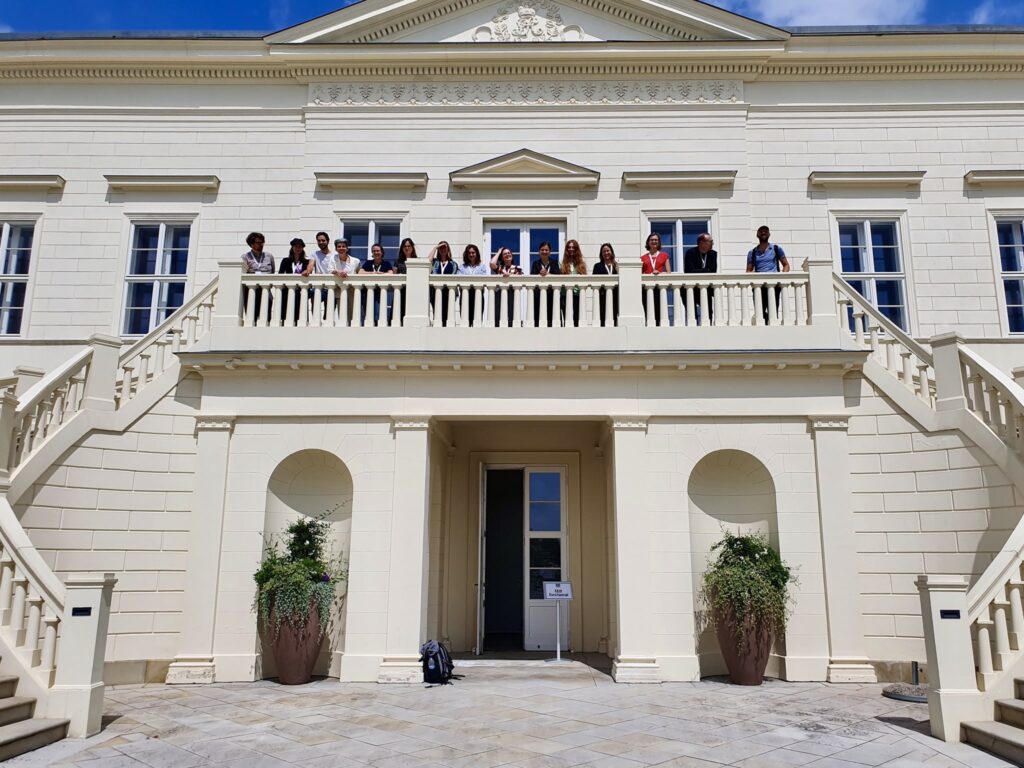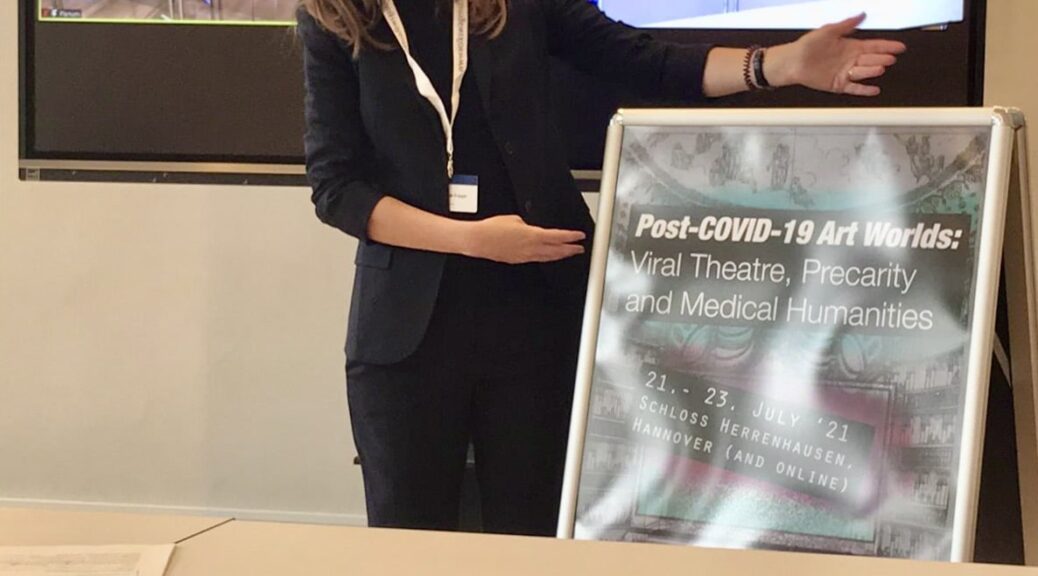
Conference Report – Post-COVID-19 Art Worlds: Viral Theatre, Precarity and Medical Humanities
Written by Alina Lange
Post Covid-19 Art Worlds: Viral Theatre, Precarity and Medical Humanities
21-23 July 2021 Schloss Herrenhausen Hannover (and Online)
Organised by:
Dr. Heidi Lucja Liedke (Universität Koblenz-Landau)
Prof. Dr. Monika Pietrzak-Franger (Universität Wien)
Going to a conference in the midst of a global pandemic is undeniably an extraordinary experience. Academic conferences are privileged spaces, and as some of the few real-life participants of this hybrid conference, we felt twice privileged. This feeling was only heightened by the splendour of what would be our venue for the following three days: generously funded by the Volkswagen Stiftung, the on-site conference took place on the premises of the illustrious Schloss Herrenhausen, Hanover, and its expansive gardens.
But first, to ensure everyone’s safety, daily COVID-testing was in order. With each of us sitting in our separate black cubicles, waiting until it was our turn, one could not help but be strangely reminded of the familiar black zoom squares that would, in many ways, accompany us throughout the conference – one of many experiences to come that would feel ‘strangely meta’. ‘Post-COVID Art worlds,’ after all, would be a live-streamed interactive conference about the question of whether or not a thing like theatre could exist in the digital world.
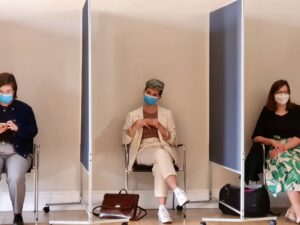
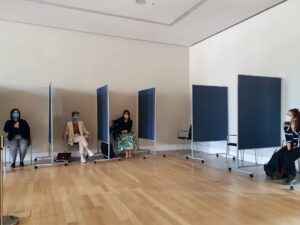
As the organisers explained in their CfP, the pandemic has affected the arts sector disproportionally. Depending to a large extent on audience participation and co-presence, theatre, in particular, has suffered heavy financial losses. In spite (and because) of the precarity of the sector, theatre-makers have been forced to get creative, many of them going online, and thereby expanding the affordances of the medium.
In some way, then, the conference served as a survey of the state of the art, or, contemporary theatre, for that matter. In another way, it aimed to initiate a theoretical conversation about the nature or ‘essence’ of theatre. The “viral” in the conference’s title, of course, has several connotations: on the one hand, it refers to the more general digitalisation of theatre and the notion of “going viral”. On the other hand, it highlights the losses, both human and financial, of the present moment. More precisely, in their opening address, Monika Pietrzak-Franger and Heidi Liedke defined viral theatre as characterised by the “interplay of three aspects: first, the fact that both performers and spectators are in a state of disruption, second, the willingness/expectations on the part of the spectators to participate in the event, and finally, the use of communication technologies such as Zoom” (128). The pandemic has posed unprecedented challenges to performers and directors – but will these changes outlast the present moment and have they changed theatre forever? To answer these questions, in the course of the following three days, we would discuss topics ranging from the ontology of theatre, notions of liveness and affect, the problem of often unacknowledged labour, and questions of access.
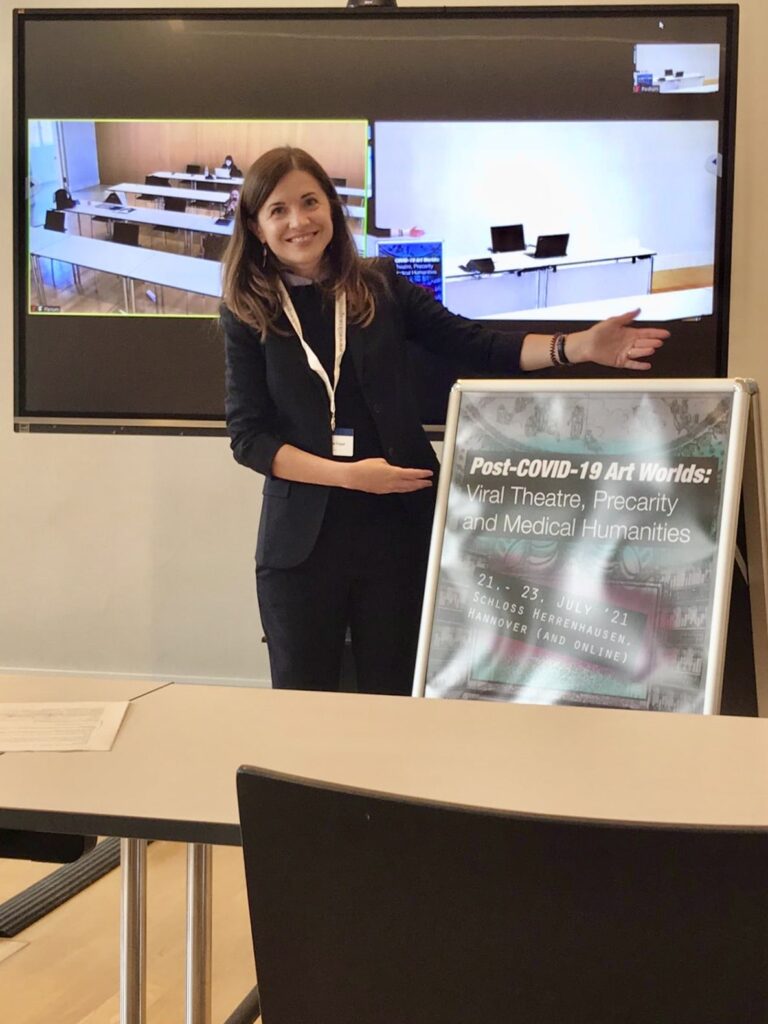
Wednesday 21 July 2021
Panel I on ‘Medical Knowledge and Media’ was opened by Jane MacNaughton’s paper “The past, present and future of COVID-19: the role of medical humanities”. She provided some necessary terminological and theoretical groundwork for our upcoming discussions. In her talk, she not only reflected on the role of medical humanities in times of COVID but also introduced some inspiring projects and suggested ways in which the arts and humanities can offer translational interventions.
The pandemic, in many ways has increased the need for mental health care. This became abundantly clear in drama therapist Amy Willshire’s poignant talk about the potential of theatre to heal and the ways drama therapy can be adapted in times of COVID. While theatre can certainly have therapeutic effects, she explained, drama therapy is more teleogical. “What has happened to you?,” (as opposed to “What is wrong with you?”) is one of the leading questions she asks patient-performers to initiate the therapy process. Her powerful river metaphor to describe the therapy process, a river that therapist and patient stride through together, resonated with many of the listeners.
The day ended with Sarah Bay-Cheng’s keynote on “Theatre without Theatre: Performance Transmission as Translation”. Introducing the concept of translation to describe the adaptation of theatre for the digital medium, she made visible the essential but often elided work of the ’translator’ in digital performance. While digitalisation might be essential for theatre’s future, the translation of digital theatre is also characterised by what she referred to as “monstrous loss”: it highlights its own gaps and failures and what ‘gets lost in translation’ but also shows what labour and technology is needed to make it possible. Citing venerable theatre critic Erika Fischer-Lichte’s blatant rejection of digital theatre, her talk also introduced what would be one of the key questions of this conference: “What is the relevance of liveness?” and “What are alternative ways and spaces in which liveness can be created?“
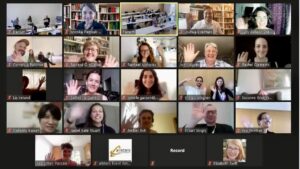
While pondering these questions (and logging off for the day), we, the on-site participants, were treated to a slap-up meal generously sponsored by Volkswagen Stiftung. Social distancing regulations (long tables for two!) and the elegant setting contributed to a truly aristocratic dining experience.
Thursday 22 July 2021
The following day started with a panel on COVID precarity and institutions. As panel moderator Julia Böll pointed out, all three of the papers of this panel looked at neoliberalism from different angles:
Bernadette Cochrane gave insights into Australia’s theatre landscape, funding, the domination of the UK’s National Theatre in live-streaming, and the limits of cultural exchange, evoking Britain’s colonial legacy.
Anna Burzyńska’s overview of Polish Post-COVID drama, “Rehearsing post-capitalist theatre”, highlighted the precarity of Polish actresses and actors and made us aware of Poland’s neo-liberal crisis management. She showed how artists have dealt with the persistent imperative to constantly produce new excellent ‘stuff’, their own precarity not preventing them from addressing the problems of people living in even more precarious conditions.
And Tamara Radak talked about transhumanist self-optimisation and the implications of ‘uploading oneself as data’. At the same time, though, she highlighted the relevance of the audience’s shared affective feelings. As one of the more conceptually-oriented papers, her talk on Dead Centre’s “To be a Machine” introduced the notion of ‘affective liveness’ as a lens through which to read interactive online performances.
Sally Shuttleworth’s keynote was dedicated to the re-working of her 2017 project “Contagion Cabaret” during the first COVID lockdown. Originally devised as a patch-work of live performance, music, and expert comments by historians and doctors, it humorously explored past and present attitudes to contagion in a fun and entertaining way. Sally described not only the logistic challenges of the adaptation’s production, but also the challenges of digitally re-creating the intimacy of the original piece. In its topicality, the 2020 ‘Contagion Cabaret’ is much more than a piece of entertainment: it becomes a historical lockdown document. Her talk prompted questions of genre, humour and ‘good taste’. Generously sharing with us experiences of her own past as a young theatre activist, Sally put forward her strong view of theatre as a medium with radically transformative powers. To her, liveness, immediacy, and co-presence have always been - and remain – essential elements of such theatre.
The following panel on COVID creativity would pick up on Sally’s creative approach to the new realities of lockdown by exploring the ways in which the pandemic has served as artistic catalyst. John Wyver opened the panel by offering a concise history of the split screen. He then presented to us the visual language of split screens that has dominated since the start of the pandemic, a new aesthetic that he termed the “language of lockdown” and that comes with its own possibilities for meaning-making. Perhaps counter-intuitively, split screens often do not serve to separate but to make connections. They have been used in increasingly imaginative ways, offering a challenge to the conventional single screen aesthetic.
A treat not just to the more tech-savvy listeners was Cyrielle Garson’s paper on the use of immersive VR technologies during the pandemic. She showed how VR’s interplay between visceral and virtual worlds has been used to engage audiences in new and exciting ways. But she also addressed its current limitations, not least the question of access. The following discussion centred on questions of democracy with regard to viewers’ perspectives. And while John lamented a certain “thingness” inherent in the VR experience, Cyrelle highlighted how VR performance must be seen as a new medium in itself, with its own specific affordances, not a mere surrogate in times of closed theatre houses.
Ulf Otto, in his paper “Theater’s digital ontology: on FOMO, relative deprivation and the privilege of presence” then shifted the focus on aesthetics that had dominated especially John’s talk. He started his presentation by describing his (no-doubt relatable) feeling of having missed the lockdown due to care duties: Theatre, contrary to what one would believe, took no break during lockdown, with increasing numbers of venues offering digital formats. Rather, he described (Post-)COVID-19 theatre as being “dead and alive at the same time”. Ulf thereby contributed to a series of paradoxes that ran like a common thread through the conference (aptly summarised by Eckart Voigts in the final roundtable presentation). He asked: How does its constant availability and circulation as digital data impact theatre and what we believe to be true about the medium? This new theatre can no longer be contained in time and place and occasionally leads virtual double lives on social media channels. But this new theatre, he showed, also entails a familiar risk: that the former privilege of presence is replaced with “privilege of presence within the digital economy” (Otto).
Rachael Nicholas and Pascale Aebischer then gave us insights into Creation Theatre and Big Telly’s highly interactive Zoom-based performance of The Tempest. Through a mixture of interviews with theatre-makers, questionnaires sent to audience members, and comparative analysis of audience data, they sought to explain the tremendous success of the collaboration’s theatre project. Starting off by reminding us of the relevance of locus and platea in early modern theatre, Rachael and Pascale detailed how these vital spaces were recreated in their digital theatre version. Through clever use of the webcam as a way of direct address, Ariel was established as a platea character that would mediate between both spaces. Describing The Tempest as ‘technology play’, they highlighted how Ariel’s liminality enabled him to move effortlesslessly between the virtual and the real world.
Bewitched by the virtual world of Prospero’s magic Island, the real-life participants then embarked on a tour through the lavish gardens of Schloss Herrenhausen, which offered many occasions to get lost. Luckily, everyone found their way back in time, because a special treat was waiting for us in the form of Creation theatre’s Duchess of Malfi. The play was less interactive than audiences of their previous Tempest-production might have expected; with actors communicating through screens with each other, and the use of overlapping screens to indicate togetherness, it did not follow the familiar zoom call aesthetic. Defamiliarizing, it was a visual treat, its 60s vintage aesthetics faintly reminiscent of Lana del Rey’s music videos. At the same time, the pop-art elements, frequent use of glaring yellow, and lots of fake blood seemed like an homage to Tarantino films like Kill Bill. The production thus managed to cleverly play with audience expectations and to reinvent itself. Borrowing from other forms and genres, they clearly stretched the borders of the Zoom medium (and, arguably, also of theatre).
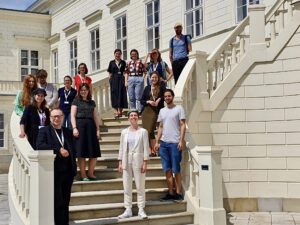
While already full with food for thought, the lovely staff of Schloss Herrenhausen then served us another lavish conference dinner. The momentary social fatigue that must be the inevitable outcome of 1.5 years of social isolation did not prevent the on-site participants from continuing the conversation and rethinking the questions of access, liveness, and democratisation that had been raised during the day.
Friday 23 July 2021
On day 3, Isabel “Izzy” Stuart kicked off the discussion on ‘COVID audiences’ with her talk on the play Overflow, a rare on-site performance she experienced right after the first lockdown. In her talk on audience experience, she cautioned us about notions of ‘collective feelings’ and considered what to make of ‘difficult feelings’ like mere indifference.
Audience researcher Kirsty Sedgman then argued that the feeling of co-presence that seems so vital to the theatre experience can be recreated through the digital. Rather than differentiating between the co-present and the digital, she suggested we talk about physical vs digital co-presence. Perhaps, she proposed, the digital offers new possibilities by being more inclusive. And perhaps, the pandemic offers theatre the opportunity to rethink questions of access and be more welcoming and barrier-free than in the past?
Opening the last panel entitled ‘On the Edges’, Marlena Tronicke introduced us to the ‘new (pandemic) genre’ of filmed monologues and the paradox reaction of introspection in response to the isolation of lockdown. BBC’s Scenes for Survival records the progress of the pandemic in the form of short one-character films and highlights the intersectionality of precarity. While she complicated the notion of precarity– a term that has been claimed by many social groups – Marlena also pointed out how the show cleverly unveils the elitism of theatre and puts the viewer in the uncomfortable position to acknowledge their own privilege.
Not only that – the show itself has to face the fact that it might contribute to the further precarity of an art form that for its ‘survival’ still very much relies on liveness and the analogue.
Richard Huddleson’s spirited plea for the recognition of the struggles of Irish-Language theatre during lockdown brought to our attention the destitution of many Irish-language theatres. Substantial budget cuts in the wake of the pandemic have further marginalised Irish theatre, a situation that has contributed to what Richard described as a “language emergency”. Already pre-COVID, theatre in Irish was not well known by or accessible to most audiences. But there was also a flicker of hope in Richard’s talk: the pandemic has opened up some exciting opportunities for Irish-language theatre, making it possible for companies to reach larger audiences and gain visibility. Importantly, this new Post-pandemic Irish-language theatre also seeks to reinvents itself and to set itself apart from more traditional and canonical approaches.
Closing our conference, Zoe Seaton, in her keynote “Hijacking the Familiar” then gave us insights into her work with Big Telly Theatre Company. A seemingly endless well of creativity, Zoe showed what is possible for theatres under lockdown when the most important maxim is to surprise. She described how her initial insecurities and reservations regarding the use of technology slowly gave way to the vital realisation “We can highjack the digital with the live!”
In the final round table with Lucy Askew, Josh Edelman, and Anna Burzyńska, moderator Eckart Voigts skilfully wrapped up the conference by highlighting some of the oppositions that the conference had brought to the fore: crises and fixes, losses and gains, threats and opportunities. Continuously, too, we were confronted with a number (Post-)Covid paradoxes: from theatre that was both “dead and alive” (or “Schrödinger’s theatre”, as Ulf Otto aptly nicknamed it) to notions of liveness and the archive. Rather than focusing on the “monstrous loss” of digital theatre, the conference has shown one thing: Perhaps, viral theatre fulfils a “fundamental need” rather than being just a gimmick (as has sometimes been claimed of VR). As our discussions of aesthetics and ontology, of affect and emotions, of audiences and politics, ethics, and access have all shown, our definitions of what theatre is or can be are continuously expanding. The ensuing round-table made this perfectly clear.
Digital theatre offers a host of opportunities. A potentially more democratic medium, it makes thinkable shifts in power relations, it can reach new communities, make known marginalized voices and stage non-canonical plays. Glitches can become springboards.
But what our discussion of the precarity of the sector also showed is that, while traditional notions of liveness may well be rethought, theatre’s insistence on liveness is also a survival strategy. And the success of digital theatre will naturally attract big industries that might try to regulate what is staged and potentially undo some of its gains. Nothing captures this latent threat better than Eckard Voigt’s reference to Netflix as “the pink elephant in the room”.
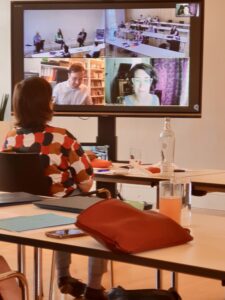
While attending this conference was without a doubt a singular experience after 1.5 years of enforced isolation, its hybridity had one advantage that also resonated as a topic through the conference: that of access. The hybrid format brought together diverse scholars and students of various career levels and from various corners of the world. Next to affordability (both in terms of money, and in terms of time – a commodity in especially short supply for scholars with caring duties), another big advantage of the format is sustainability. In some ways, then, the conference also created a – sometimes uncomfortable – awareness of our own privilege as on-site attendants in such sumptuous surroundings.
And still, despite its imperfections, its “gaps and fixes”, digitalisation has, at least partially, made possible what has been cited almost to the point of cliché: being together even when we’re apart.
